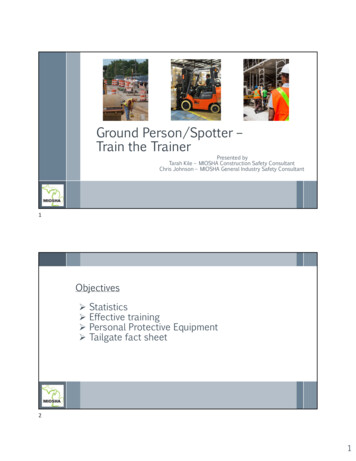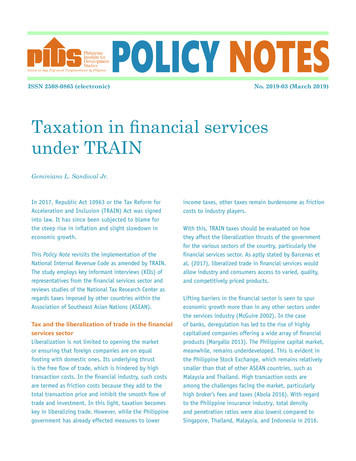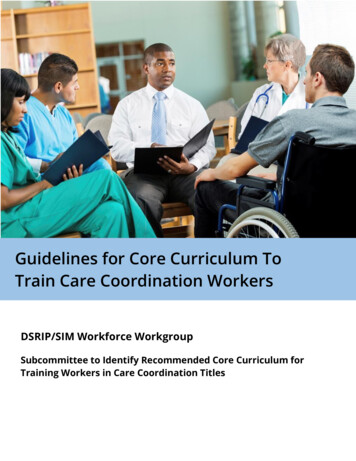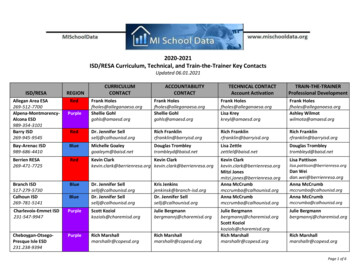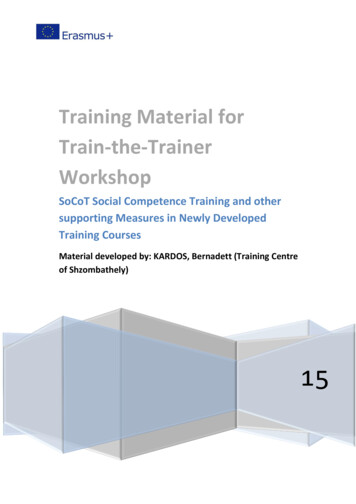
Transcription
Training Material forTrain-the-TrainerWorkshopSoCoT Social Competence Training and othersupporting Measures in Newly DevelopedTraining CoursesMaterial developed by: KARDOS, Bernadett (Training Centreof Shzombathely)15
Table of ContentsBrief Description of the Training . 2General Information about the Training Material . 3Brief Description of the Subject Matters of the Trainer Training . 6Training Day 1 . 7Summary table . 7Description of Activities of Training Day 1 . 9Training Day 2 . 22Summary table . 22Description of Activities of Training Day 2 . 24Training Day 3 . 35Summary table . 35Description of Activities of Training Day 3 . 37Bibliography. 47
Brief Description of the TrainingTraining Objectives: To prepare group leaders with experience in delivering labour-markettraining for sessions to be delivered within the framework of the project 'Social competencetraining and other supporting measures in newly developed training courses'.Direct Target Group of the Training: trainers with experience in delivering training tofacilitate labour market reintegration of NEET young people.Indirect target group: Young people aged between 16 and 32 who are disadvantaged from alabour market perspective.The Training: reinforces group leadership competences and familiarises them with thetraining material.Training the trainers indirectly contributes to addressing problems of the target group – NEETindividuals. Participants admitted based on preliminarily laid down input specificationsacquire knowledge and abilities during the training which enable them to apply the trainingmaterial produced within Erasmus framework for NEET young people and to deliver thetraining.Expected Outcome of the Training: preparing trainers to deliver the content of the curriculumsessions effectively.Duration of the Trainer Training: 3 training days, 30 hours altogether (3 x 10 hours)Training Content :- getting to know each other- motivation, shaping attitude- information about the curriculum- developing trainer skills with mock leadershipsWhen producing the training material, the trainer’s pre-existing knowledge of the labourmarket and their professional experience were taken into consideration.
General Information about the Training MaterialFinalising the training material was done in a number of phases: a pilot project of the firsttraining material was tested. Secondly, Trainers shared their recommendations andexperiences about receiving this training and delivering sessions for unemployed peoplewhich were utilised to produce the training material.Criteria to be considered when producing the training material:This programme aims at producing the material of a three-day preparatory training. Thus, it isa prerequisite for trainers to be admitted to have preliminary knowledge and experience indelivering reintegration trainings for NEET people. The below criteria shall be consideredwhen selecting group members to be trained.- tertiary educational attainment: preferably a degree in Humanities- experience in working with NEET people- experience as a trainerThese entry criteria assure that trainees, resulting from their education, have preliminaryknowledge of psychology, pedagogy and methodology, besides having experience indelivering trainings. It serves a ground for participants to acquire knowledge which enablesthem to deliver sessions within the framework of the project.When determining criteria of the training material, special attention was paid to awarenessraising and skills development.Structure of professional content of the training days:1. summary table of the syllabus of the day (with methodological references)2. description of activities3. annexes of activities, questionnaires, etc. of the dayThere is a structure and time schedule recommendation for each day shown in the summarytables. Group leaders will have to adapt it flexibly (meeting the objectives and contentrequirements) to specific characteristics of the group when delivering the training. Theremight be topics or activities which require more detailed elaboration in a certain group. Somegroups/members may differ regarding their speed of working. In practice, more considerabledifferences may arise than expected.Time for relaxing activities is not indicated in the training material. The role of these is alsocrucial: they are necessary for the participants to relax and sustain their attention. Groupleaders may apply such activities any day, in accordance with momentary mood of groupmembers.It is essential to take breaks in every training. Time for breaks is basically not determined inthe training material (except for Training Day 3), since tolerance of workload and necessity
for a break may vary considerably in each group. Time must be managed responsibly bygroup leaders and they are the ones to determine length and time of breaks.To implement professional contents specified for a given day, alternative activities may alsobe done in order to allow trainers maximum freedom in their work. Considering objectivesand special characteristics of each group and in accordance with their own leadership styleand trainer competences, trainers may select from the activities described.Methods applied in the training material:- structured activity- metaplan technique- instruction- short presentation- observation- managed self-disclosure- test sheet (self-assessment and commenting on others)- role-play- skills practice- free interaction- educational conversationTypes of work during the training:- large group work- small group work- individual workPersonal requirements for group leaders to receive the training:- tertiary educational attainment: preferably a degree in Humanities- experience in working with NEET people- experience in trainer training- experience in delivering trainings for NEET peopleFacilities of the training: venue, equipment, toolsAn important aspect of delivering the training is a training room that meets the requirementsbelow:- considering public transport connections: easily accessible- disturbance free environment (in a peaceful, quiet location)- accessible for people with disabilities- social rooms are available- its size and furniture make it capable of hosting the training
Tools necessary for the training:- training material (booklet containing description of the activities)- photocopier- computer, printer- sheets of paper- flip chart and paper- markers- stationery- video camera- projector
Brief Description of the Subject Matters of the Trainer Training1.Getting to know each other, establishing operational frameworkAims: to strengthen group cohesion and support inclusion into the trainingSupports: familiarising with the training venue, establishing group rules, setting andclarifying operating conditionsExpected outcome: promoting formation of a cohesive group2.MotivationAims: to build awareness of delivering labour-market training for NEETsSupports: awaking consciousness of personal resources regarding supportive attitude andrelationship with the target group of the projectExpected outcome: reinforced commitment towards supporting NEETs3.Getting to know the curriculumAims: to prepare to deliver the training for NEETsSupports: providing information about the training material produced within theframework of the project, clarifying contentsExpected outcome: Trainers are prepared to deliver the training4.Developing trainer skillsAims: to develop trainer competence of participantsSupports: shaping attitude of trainers, awaking consciousness of trainer styles byproviding feedback, improved consciousness of elements of efficient communicationExpected outcome: developed trainer skills, trainer personality and communication styles
Training Day 1Summary tableDuration: 10 HoursSession Delivery:PhasesContentStart Welcome Speech by theLeader of the TrainingInstitute, a Brief Presentationon the Programme-Trainers briefly iners andLet's Get in Touch!participants getacquaintedShort introductory roundEstablishin Setting goalsgoperationalframework Mappingexpectations,anxietiesLaying downgroup rulesIntroducing Change,&personalprocessing involvementnew topicMethodTime15 minutes5 minutesGuidedactivity15 minutesSociometryIndividualutterances30 minutesWhat I share about myself(selecting and presentingsymbolic objects)'Presentations'60 minutes3-5 QuestionsInterviewPresenting the completeprogrammeShortpresentation15 minutesCompleting sentencesCompletingtests,individualwork25 minutesHaving the rules acceptedLarge groupdiscussion15 minutesChange in My LifeIndividualworkLarge groupdiscussion50 minutes5-10minutes
I have become an assistantConversationin pairsLarge groupdiscussion40 minutesGenuinechangeIntroducing Model of Changeof Prochaska et al.Shortpresentation30 minutesInitiatingchangeNecessity of change from aSmall grouplabour market perspective inworkthe life of NEET young people Metaplantechnique50 minutesResponsibilityof groupleaders ininitiatingchangesWhat am I capable of? - Mystrengths!Individualwork30 minutesIntroducing Assessment for A Way to Promotenew topic sation90 minutesIntroducing,processingnew topicSurveying the TrainingMaterial Prepared JointlyDuring the ProjectTrainerpresentationLarge group workQ&AFree interactionPreparing a Schedule forMicro-LeadershipActivitiesFree interaction20minutesEmotions, thoughts at theend of the dayTaking turns10minutesPreparation fordelivering thetraining: gettingto know thetraining materialEnd of the day Feedback90minutes
Description of Activities of Training Day 1Welcome Speech by the Leader of the Training Institute, a Brief Presentation on theProgrammeAt the beginning, the leader and the staff of the training institute welcome the participants ofthe training.Besides formally initiating the programme, it is also essential to emphasise and makeparticipants aware of the importance and social significance of their activities. This mightwell contribute to affirming their commitment.Initially, the institute leader briefly describes the aims and activities of the project, andintroduces the trainers delivering the training.Brief Introduction from the Trainer(s)Activity Objectives: To network and establish rapportAfter the group has started working, the trainer(s - dual guidance) briefly introducethemselves providing a brief overview of their professional activities and competences whichenable them to deliver the Train the Trainer programme.Let's Get in Touch!Activity Objectives: Group members to networkThe trainer asks the members to create space to facilitate movement by placing the seats nearthe walls. After that, they are asked to start walking up and down in the room at a pace anddirection of their choice. The activity has several phases and the instructions are givenaccording to the rhythm of the activity – leaving enough time for each phase:- while walking, they should look around and familiarise with the furniture and ambianceof the training room- they should direct their attention from the outside to the inside, be aware of themomentary emotions and thoughts related to the training- they should pay attention to their peers, make eye contact with everybody, and shakehands to greet each other. They also have to stop shortly then, and move on towardsothers. The trainer might join in to this part of the activity. After meeting everybody, theyshould stand still at a point of the room they feel comfortable.Short Introductory RoundActivity Objectives: At professional training like this one, some participants are expected tohave met before. It is essential to map already existing personal networks which affect thetraining as a whole.Members are required to scatter around the room so that distances to each other express theintensity of their previous relations. (They should stand close to ones they already know andfurthest from ones they have just met.) Finding their position is a non-verbal activity,speaking is not allowed. When everybody has found a comfortable position in the room,members start describing their reasons for their choices and the details of their relationships to
others. The trainer obtains information about the quality of the relationships based on theatmosphere and the non-verbal message given.After completing the activity, participants take a seat in a circle.What I Share about Myself 1 (Selecting and Presenting Personal Objects)Activity Objectives: To get to know each other and networkThe trainer asks the participants to consider their clothes and objects they have, 'scan' theirbags and pockets and choose an object they regard as important or like, which they will use tointroduce themselves in speaking. If they cannot find a suitable one, they might choose fromthe objects present in the room. Experience suggests that members are surprised first but inthe end, everybody finds a suitable object.The instruction has no constraints regarding the subject matter; everybody is free to choosewhat to talk about. An advantage of this is that participants speak spontaneously about theirrelationships, values and priorities in life.Variation of the activity: group members are asked to find an object which expresses theirattitude as a trainer symbolically.What I Share about Myself 2 (Selecting an Object)An alternative to the above activity might be the trainer putting some objects to the middle ofthe circle and the participants choose one according to the instructions described earlier.After that, participants introduce themselves taking turns.3-5 QuestionsActivity Objectives: To get to know group leaders, networking, providing examplesIf the participants would like to learn more about the trainer as well, he/she should create anopportunity for it. The group have the possibility to ask altogether 3 or 5 questions to thetrainer. The number of questions is set by the trainer in the specific community. No constrainton the subject matter should be placed, but obviously too intimate or indiscreet questionsshould be avoided. They might be wittily parried with humour. The activity promotescooperation between group members. Besides, it provides participants with examples of howto deal with more dynamic (dominant), perhaps indiscreet group members in their owngroups.Presenting the Complete Training ProgrammeActivity Objectives: To transfer knowledge and raise awareness.The trainer describes the professional content, schedule and goals of the group sessions of thetraining.Participants of the Train the Trainer programme receive a copy of the training materialprepared for training NEETs (in paper or electronic format) upon admission to the group forpreliminary studies. /Since the Train the Trainer programme is the cornerstone of deliveringthe training for NEETs, preparation for micro-leadership activities of participants in theprogramme must be commenced. An essential prerequisite is to present the training material./The group leader answers the participants' questions.
My Expectations & WorriesActivity Objectives: To establish a cohesive groupThe trainer hands out the 'My Expectations & Worries' worksheet to the participants (Annex1) The participants complete it individually. The sheet is then cut in 4 and the pieces are puton a flip chart by the members, grouped by topics. The group leader reads them and reacts tothem according to their content: if necessary, he reassures, provides information, explains,etc.Acceptance of Rules 1Activity Objectives: To establish a cohesive groupSince participants of the training are experienced leaders, the activity is mostly about awakingconsciousness of the current situation, which could be carried out in a simplified version.The trainer hands out a list of the possible operating rules of the group (Annex 2). Participantsare asked to put a cross in the boxes to indicate rules which they deem indispensible for thegroup to operate. After that, the statements are read by the trainer and members vote for themby show of hands. The group leader tries to comply with every request, the aim of which is tomake everybody feel comfortable when working together. (Group members will hopefully betolerant of each other and will comply with even more specific needs.)Completing the activity, the trainer reads out the operating rules of the group loud. Later itmight serve as a basis of reference.Acceptance of Rules 2Activity Objectives: To establish a cohesive groupAn alternative to the previous activity might be the trainer projecting the list of rules on aninteractive board where the members take turns putting a dot next to every statement theydeem important for the group to operate. The method facilitates clear visualisation of rules themajority prefers, and ones which are not considered important to be laid down.During the activity, the leader follows the same procedure as that of the previous one.Change in My LifeActivity Objectives: To recall personal experiences necessary for introducing the topicThe trainer asks group members to recall one of their remarkable life changing events. Thosewilling to share it are allowed to do so, but it is not obligatory. Then the 'Change in My Life'worksheet (Annex 3) is handed out and group members are asked to analyse the life eventaccording to the given criteria.After filling in the sheet individually, the group tries to draw general conclusions on whatcircumstances bring about changes, what conditions are favourable and what factors pose anobstacle to them.
I have become an assistantActivity Objectives: To raise awareness of creating the identity of an assistant and to raiseawareness of labour-market related effects of individual life eventsThe trainer asks participants to choose a partner via eye-contact; they have a conversation inprivate about whether they have had any changes in their lives which contributed to theirdecision of choosing a job as an assistant. Those willing may share information aboutthemselves in the large group; the trainer only requests everybody to briefly share whatemotions they felt during the conversations.Introducing Model of Change of Prochaska et al.Activity Objectives: To transfer knowledge and motivateThe trainer provides a short summary of the Model of Change by Prochaska, emphasising thefact that changes occur as a result of a process. Raising awareness to the necessity forchanges, preparations for them and strengthening commitment present a real challenge fortrainers. It is also worth mentioning that relapses experienced in the process of achieving aimsare natural, and managing them competently is key in recognising the road to overall change.The trainer hands out the worksheet introducing the model to the participants (Annex 4).Necessity of Change from a Labour Market Perspective in the Life of NEET YoungPeople 1Activity Objectives: To organise information and collect resourcesRelying on their previous experience, participants gather on a piece of paper the areas youngpeople require changes in to facilitate their labour market re-integration. (e.g. establishinglabour-market objectives, considering time management, etc.) Participants write eachstatement on a separate piece of paper, and following the small group work, they group anddiscuss the contents and brainstorm ideas how they could facilitate changes when workingwith a group of young people.Necessity of Change from a Labour Market Perspective in the Life of NEET YoungPeople 2Activity Objectives: To organise information and collect resourcesAn alternative to the above activity could be the trainer handing out the 'Circumstances andAttitudes Influencing the Life of NEET Young People' worksheet (Annex 5) for individual orsmall group work. Participants study and group the list considering the following aspects:- What are the factors that could be influenced during the training; the ones the sessionscan affect?- Which ones are out of the competence of the training?The opinions are then discussed in the group under the guidance of the trainer.
What am I Capable of? - My StrengthsActivity Objectives: To raise self-awarenessSince participants of the training are all experienced trainers, they are aware of their owngroup-leadership strengths. During the preparation phase, time is devoted to the activity sothat these strengths are fully activated when delivering the training.Group members are asked to write down on a piece of paper what they consider their mostimportant virtue and positive feature in terms of delivering a labour-market training. Avolunteer reads out their words and places the sheet inside the circle on the ground. Movingaround, everybody reads out their strengths and places the sheets on the ground: next to onesthey feel close to theirs (a sociometric type of grouping is carried out). Afterwards, peoplesharing similar contents make small groups where they discuss:- how their strengths manifest on a behavioural level in group work.- what beneficial effects they can bring about in group members.- whether it might have any harmful effects during work. If so, how it could be avoided.A Way to Promote DevelopmentActivity Objectives: To transfer knowledge and raise awareness.Using a ppt file, the trainer delivers a presentation about the methodology of 'Assessment forLearning'.Then, the leading trainer hands out a brief summary of the AfL technique (Annex 6), whichparticipants study individually.After that, the leading trainer has a guided conversation with group members, where he/sheleads the discussion in a way he/she feels appropriate. Some contents recommended for theconversation:- What elements of 'AfL' have you applied in your work so far?- What new ideas have you heard?- exchanging experience with others about the method – asking questions about how toapply new ideas, consultation- Which of the contents you have just learnt did you like? Which of them are youplanning to use in the future?Surveying the Training Material Prepared Jointly During the ProjectActivity Objectives: To transfer knowledgeThe trainer gives a short presentation on the aim, conception and structure of the trainingmaterial facilitating labour-market re-integration of NEET young people.Q&AActivity Objectives: To clarify contents and answer questionsGroup members are free to ask questions regarding the training programme to the trainer(since there has been an opportunity to study the material beforehand, members with groupleadership experience are expected to ask specific and practical questions.)Having familiarised with the training material for the unemployed, members of the groupcollect activities they do not understand after reading their description; ones they would not
be able to deliver in a group of unemployed people. These are then discussed with the trainer,and on request, he/she demonstrates the activity.Should a member propose any modification of an activity of the training booklet, it will alsobe discussed.Preparing a Schedule for Micro-Leadership ActivitiesActivity Objectives: To establish operating frameworkEvery group member chooses an activity (for individual or dual leadership) which they willlead with the contribution of others on one of the forthcoming two training days (othermembers will play the role of unemployed people). The trainer tries to encourage participantsto take on the leadership of an activity in the training material which presents a challenge forthem.Members compare their choices with the trainer and each other.Following the discussion, a schedule is arranged including information about activities led byindividual members and the order of micro-leaderships.Participants are asked to get prepared for micro-leadership activities beforehand; they mightask for help from trainers, of course.Materials are provided by the trainer.Feedback Round - Feelings, Thoughts at the End of the DayParticipants of the training briefly summarise their experiences of the first training day.It is worth having everyone put into words the contents they deem necessary to deliver thetrainings.
(Annex 1)My Expectations & WorriesRegarding the training, I expect.Regarding the training, I'm worried.
For a successful training, I expect the trainer For a successful training, I can offer.and others.(Annex 2)Group rulesPut a X into the boxes to indicate rules you would like to introduce during the training. Markevery rule you consider important.Arrive on time for joint work (at the start of a day and after breaks).Turn off or mute mobile phones during sessions.Do your best and actively cooperate during sessions.Express yourself succinctly to use time efficiently.Respect each other's opinion (group secrecy).
Assist each other in preparation for micro-trainings.No information shall be provided to third parties about participants of the training.Other proposal:Other proposal:
(Annex 3)Change in My LifeAnswer the following questions briefly. You are free to share anything of the content youhave written with other group members.What events and facts raised my awareness to the need for change?What difficulties and emotions did I experience when I started to feel the need for change?What energy-investment did I make to facilitate change?How did change affect my schedule?How did change affect my lifestyle?How did change affect my relationships?What emotions did I experience after the change?
(Annex 4)The Model of Change of Prochaska et al.Pre-contemplation: The individual has not identified the problem. They resist change even in spite ofexternal pressure. To do so, they exclude subject related information from their lives, deny existenceof the problem, and refuse to accept responsibility.Contemplation: The individual recognises the problem and starts looking for possible solutions. Theymight have action plans, but are not committed to implementing them. They focus on the probleminstead of the solution.Preparation: The individual becomes committed to taking actions and becomes ready for it.However, it is also necessary for them to resolve ambivalences which hinder taking genuine actions. Itis worth outlining a detailed action-plan.Action: there are definite changes in behaviour. There is a need for absolute commitment andboundless energies in this phase.Maintenance: it is a time to reinforce achievements and successes of previous phases, and to preventwavering; falling back into previous behaviours. It is a long process.Termination: there are problems which can be actually closed, however there are ones which have tobe addressed through a lifetime.Relapse: natural part of the process. Discovering reasons of relapse might help prevent it in the future.Source: Prochaska, J.O., Norcross, J.C., DiClemente, C.C., (2009) Valódi újrakezdés [Changing forGood], Ursus Libris, Budapest.
(Annex 5)Circumstances and Attitudes Influencing the Life of NEET Young PeoplePut a X into the boxes to indicate factors which could be shaped, influenced during labourmarket trainings. If possible, write an idea to the factor indicated about how the desiredchange could be achieved. self-estimation problems (inferiority complex, lack of self-confidence) disadvantaged social status, lack of motivating environment, retaining environment lack of work experience lack of family support, and its retaining force relationships to peers, unfavourable effects of reference group lack of social competences low level of conformity and resilience skills unrealistic thinking learnt helplessness communication difficulties (self-expression, understanding other people's thoughts) dominance of external factors in actions (low level of internal control) lack of persistence / effort, miracle-expecting attitude difficulties in time-management problems with way of living unrealistic values dominance of 'I feel good' attitude disorganised lifestyle motivation difficulties, lack of definite goals lack of a realistic goal weak study skills and motivation lack of an example to follow other factor: . other factor: .
(Annex 6)A Way to Promote DevelopmentAssessment for Learning'Assessment for Learning [.] refers to frequent, interactive assessments of student progressand understanding to identify learning needs and adjust teaching appropriately'. Thisdefinition of AfL by OECD implies application of the
training material was tested. Secondly, Trainers shared their recommendations and experiences about receiving this training and delivering sessions for unemployed people which were utilised to produce the training material. Criteria to be considered when producing the training material: This programme aims


